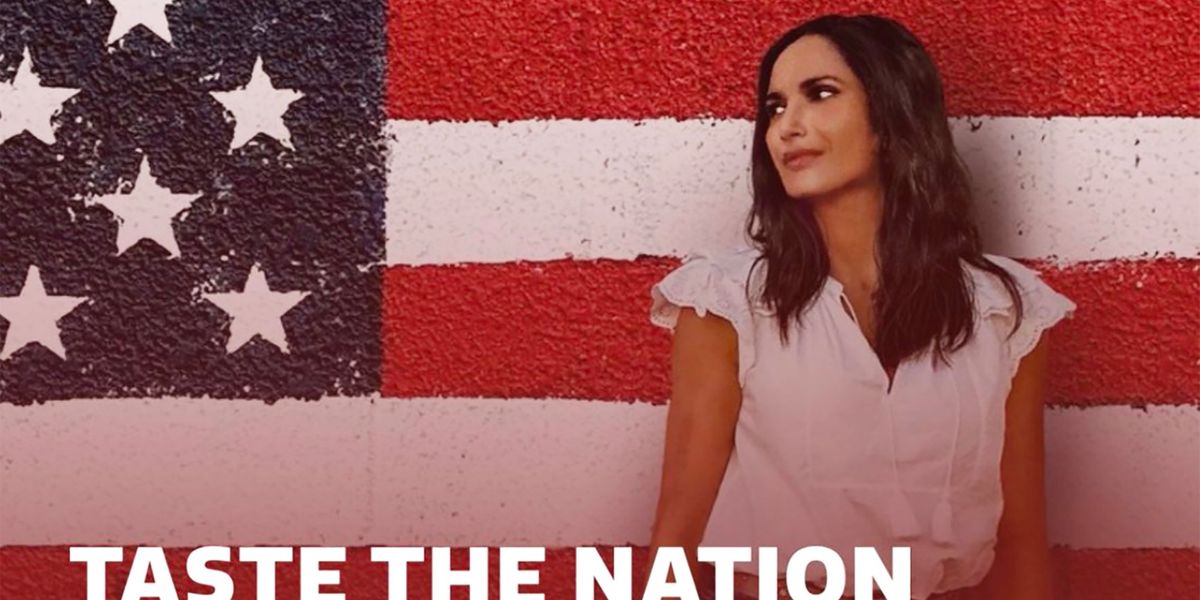In the era of peak TV, food shows have become a popular fixture on streaming services. Hulu’s latest entry into the genre, Taste the Nation, which premiered in June 2020, feels both familiar and strange. Featuring the beautiful photography of a travelogue and the cheerful tone of a cooking show, Taste the Nation also serves as a necessary history lesson on slavery, colonialism, immigration and its interrelated processes of assimilation, displacement, and resistance — all of which have helped construct the American nation.
Hosted by the ultra charismatic
Padma Lakshmi, Taste the Nation reveals its true intentions early in the first episode, “Burritos at the Border”, set in El Paso, Texas. In voiceover narration, Lakshmi notes: “Americans love Mexican food. In fact, we eat more salsa than we do ketchup. But what about the hands that make the food?”
Taste the Nation is more interested in centering the experiences of the communities and peoples that produce the food we consume rather than the food itself. Throughout ten 30-minute episodes, the series highlights that many of the popular dishes that have become a staple of the American diet, such as tacos, dosas and kabobs, are inextricable from stories of migration, pain, nostalgia, hard work, and sacrifice.
In an interview with
Eater, Lakshmi explained that Taste the Nation came about as a result of having worked with the American Civil Liberties Union after the election of Donald Trump in early 2017. Appalled by the administration’s rampant vilification of immigrants, Lakshmi wanted to create a series that used food as a vehicle to explore complex issues of migration, identity, and heritage.
With its title and promo shots that feature Lakshmi clad in blue jeans and a white blouse standing in front of a US flag (Bruce Springsteen’s Born in the U.S.A. album cover comes to mind), Taste the Nation may at first glance seem like a celebratory show about American food. But as The Atlantic points out, Taste the Nation works as a “Trojan horse” for how it exposes the hypocrisy of a nation that selectively appropriates ethnic foods to bolster its melting pot mythology, while it consistently degrades and rejects the very people who make these foods. As one of the Mexican-American chefs featured on the first episode bluntly states: “People accept tortillas before they accept my cousins.”
Taste the Nation is a fascinating series that provides a much-needed historical context to cuisines we tend to take for granted. It reminds us that food, rooted in histories of empire, is always political. For example, on the fourth episode, “The Gullah Way”, Lakshmi travels to Charleston, South Carolina, to visit the Gullah Geechee community. Direct descendants from slaves, the Gullah Geechee people have been “the backbone of the American South” for centuries, as Lakshmi notes, and yet, they have been forgotten. While their food has been assimilated and diluted into the generic “soul food” label, the Gullah Geechee people have to constantly struggle against gentrification, tourism, and the devastating effects of global warming in order to preserve their way of life.
In one of the most poignant episodes, “The Original Americans”, Lakshmi visits Native American peoples in Phoenix, Arizona, and provides visibility to one of the most marginalized segments of the US population. Having been decimated by mass genocide, Native American communities in reservations suffer from high rates of obesity, alcoholism, and drug addiction, because their access to healthcare and fresh food is deliberately limited. Many of the people featured on the episode tell Lakshmi that achieving food sovereignty is crucial to revitalize Native American communities.
At the end of the episode, they prepare a “decolonized Thanksgiving” dinner for Lakshmi using only foods found on their land and traditional methods of cooking, illustrating what scholars Adele Wessel and Andrew Jones call “the creative possibilities for recontextualising colonialism’s meanings.” In other words, these alternative practices are one way in which Native Americans can reclaim their history and culture.
If there’s one complaint to be had about Taste the Nation, it’s the relentless optimism about the possibilities of food to overcome the deeply entrenched ideologies of racism and xenophobia. This is perhaps most evident in the sixth episode, “Where the Kabob Is Hot”, which highlights Persian food in Los Angeles. In voiceover narration, Lakshmi states: “I hope that breaking bread together can finally help us overcome some of these ridiculous misconceptions” that plague the Iranian-American community in the US.
In a conversation with the comedian Maz Jobrani, he tells her that the kabob is a sort of “olive branch to Americans”: it is nonthreatening. But Taste the Nation fails to question why immigrants must work to neutralize their differences in order to appear nonthreatening in the first place. Moreover, it seems misguided to think that food alone can undo centuries of anti-immigrant policies that are ingrained in the fabric of the American nation.
Nevertheless, Taste the Nation is a terrific show that radiates warmth and empathy for all ethnic communities: black, brown, indigenous, and Asian peoples who continue to be oppressed in the US. In a year defined by a global pandemic, we could all use more shows like the Taste the Nation that both entertain and educate.
Works Cited
Gilbert, Sophie. “Padma Lakshmi’s New Food Show Is a Trojan Horse”. The Atlantic. 8 July 2020.
Kludt, Amanda. “Padma Lakshmi Is Tired of Being Delicate”. Eater. 22 June 2020.
Wessel, Adele & Andrew Jones. “Reading Religion and Consuming the Past in the Feast of Guadalupe”. Anthropology of Food. May 2006.


